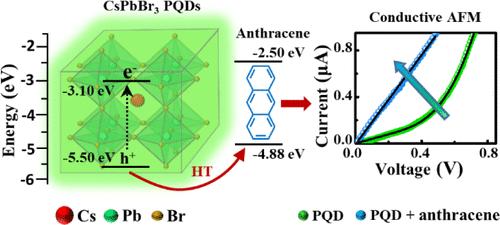CsPbBr3 Perovskite 量子点界面的空穴诱导电荷转移动力学
IF 3.2
3区 化学
Q2 CHEMISTRY, PHYSICAL
引用次数: 0
摘要
在寻求推进太阳能转换的过程中,了解界面电荷转移(CT)的复杂性已成为光伏应用的关键。高效的电荷转移对于最大限度地减少重组造成的能量损失和提高设备效率至关重要。在此,我们通过光谱和显微测量来深入研究 CT 过程对改善跨界面电流传导的重要意义。我们利用带准空穴受体蒽探索了 CsPbBr3 包晶量子点 (PQD) 中的光诱导 CT 机制。所有光谱测量结果都显示,通过能级图和态密度计算,从 PQDs 到蒽的空穴传输发生了显著的 CT。使用导电原子力显微镜对电极-半导体-电极结进行的电学测量表明,在引入蒽之后,PQD 的电导率有所增加。在 PQD 中加入蒽改变了电流-电压曲线的性质,使其从非线性曲线变为欧姆曲线,分别显示出含有蒽和不含蒽的 PQD 只有直接隧穿以及直接隧穿和 Fowler-Nordheim 隧穿。这些发现有助于通过精心选择简单的分子作为电荷传输层或一些附加层来开发高效、经济的光电器件。本文章由计算机程序翻译,如有差异,请以英文原文为准。

Hole-Induced Charge Transfer Dynamics at the CsPbBr3 Perovskite Quantum Dot Interface
In the quest to advance solar energy conversion, understanding the intricacies of charge transfer (CT) at interfaces has become crucial for photovoltaic applications. Efficient CT is essential for minimizing energy losses due to recombination and enhancing the efficiency of the devices. Herein, we delve into the significance of the CT process in the improvement of current conduction across the interface by using several spectroscopic and microscopic measurements. A photoinduced CT mechanism in CsPbBr3 perovskite quantum dots (PQDs) is explored with a band-aligned hole acceptor, anthracene. All of the spectroscopic measurements reveal a prominent CT from PQDs to anthracene through hole transfer, as evinced from the energy level diagram and density of states calculations. The electrical measurements across an electrode-semiconductor-electrode junction using conductive atomic force microscopy reflect an increase in the conductance in PQD after the introduction of anthracene. The inclusion of anthracene in the PQD changes the nature of the current–voltage curve from nonlinear to Ohmic one, revealing only direct tunneling and both direct and Fowler–Nordheim tunneling for PQD with and without anthracene, respectively. These findings can contribute to the development of efficient and cost-effective optoelectronic devices with a careful selection of simple molecules as charge transport or some additional layers.
求助全文
通过发布文献求助,成功后即可免费获取论文全文。
去求助
来源期刊

The Journal of Physical Chemistry C
化学-材料科学:综合
CiteScore
6.50
自引率
8.10%
发文量
2047
审稿时长
1.8 months
期刊介绍:
The Journal of Physical Chemistry A/B/C is devoted to reporting new and original experimental and theoretical basic research of interest to physical chemists, biophysical chemists, and chemical physicists.
 求助内容:
求助内容: 应助结果提醒方式:
应助结果提醒方式:


